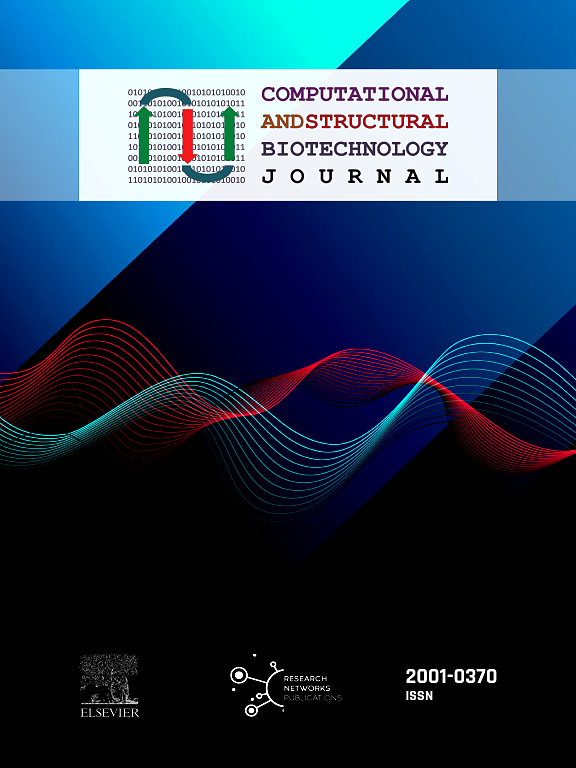Identification and biophysical characterization of epitope atlas of Porcine Reproductive and Respiratory Syndrome Virus
IF 4.4
2区 生物学
Q2 BIOCHEMISTRY & MOLECULAR BIOLOGY
Computational and structural biotechnology journal
Pub Date : 2024-09-10
DOI:10.1016/j.csbj.2024.08.029
引用次数: 0
Abstract
Porcine Reproductive and Respiratory Syndrome Virus (PRRSV) have been a critical threat to swine health since 1987 due to its high mutation rate and substantial economic loss over half a billion dollar in USA. The rapid mutation rate of PRRSV presents a significant challenge in developing an effective vaccine. Even though surveillance and intervention studies have recently (2019) unveiled utilization of PRRSV glycoprotein 5 (GP5; encoded by gene) to induce immunogenic reaction and production of neutralizing antibodies in porcine populations, the future viral generations can accrue escape mutations. In this study we identify 63 porcine-PRRSV protein-protein interactions which play primary or ancillary roles in viral entry and infection. Using genome–proteome annotation, protein structure prediction, multiple docking experiments, and binding energy calculations, we identified a list of 75 epitope locations on PRRSV proteins crucial for infection. Additionally, using machine learning-based diffusion model, we designed 56 stable immunogen peptides that contain one or more of these epitopes with their native tertiary structures stabilized through optimized N– and C–terminus flank sequences and interspersed with appropriate linker regions. Our workflow successfully identified numerous known interactions and predicted several novel PRRSV-porcine interactions. By leveraging the structural and sequence insights, this study paves the way for more effective, high-avidity, multi-valent PRRSV vaccines, and leveraging neural networks for immunogen design.猪繁殖与呼吸综合征病毒表位图谱的鉴定和生物物理特性分析
自 1987 年以来,猪繁殖与呼吸综合征病毒(PRRSV)一直对猪的健康构成严重威胁,因为其变异率高,给美国造成了超过 5 亿美元的巨大经济损失。PRRSV 的快速变异率给开发有效疫苗带来了巨大挑战。尽管最近(2019 年)的监测和干预研究揭示了 PRRSV 糖蛋白 5(GP5;由基因编码)在猪群中诱导免疫原性反应和产生中和抗体的作用,但未来的病毒世代可能会产生逃逸突变。在这项研究中,我们确定了 63 种在病毒进入和感染过程中起主要或辅助作用的猪-PRRSV 蛋白-蛋白相互作用。通过基因组-蛋白质组注释、蛋白质结构预测、多重对接实验和结合能计算,我们确定了 PRRSV 蛋白上对感染至关重要的 75 个表位。此外,利用基于机器学习的扩散模型,我们设计出了 56 种稳定的免疫原肽,这些肽含有一个或多个这些表位,并通过优化的 N 端和 C 端侧翼序列稳定了它们的原生三级结构,还穿插了适当的连接区。我们的工作流程成功鉴定了许多已知的相互作用,并预测了几种新的 PRRSV 与猪的相互作用。通过对结构和序列的深入了解,这项研究为研制更有效、高活性、多价的 PRRSV 疫苗以及利用神经网络进行免疫原设计铺平了道路。
本文章由计算机程序翻译,如有差异,请以英文原文为准。
求助全文
约1分钟内获得全文
求助全文
来源期刊

Computational and structural biotechnology journal
Biochemistry, Genetics and Molecular Biology-Biophysics
CiteScore
9.30
自引率
3.30%
发文量
540
审稿时长
6 weeks
期刊介绍:
Computational and Structural Biotechnology Journal (CSBJ) is an online gold open access journal publishing research articles and reviews after full peer review. All articles are published, without barriers to access, immediately upon acceptance. The journal places a strong emphasis on functional and mechanistic understanding of how molecular components in a biological process work together through the application of computational methods. Structural data may provide such insights, but they are not a pre-requisite for publication in the journal. Specific areas of interest include, but are not limited to:
Structure and function of proteins, nucleic acids and other macromolecules
Structure and function of multi-component complexes
Protein folding, processing and degradation
Enzymology
Computational and structural studies of plant systems
Microbial Informatics
Genomics
Proteomics
Metabolomics
Algorithms and Hypothesis in Bioinformatics
Mathematical and Theoretical Biology
Computational Chemistry and Drug Discovery
Microscopy and Molecular Imaging
Nanotechnology
Systems and Synthetic Biology
 求助内容:
求助内容: 应助结果提醒方式:
应助结果提醒方式:


